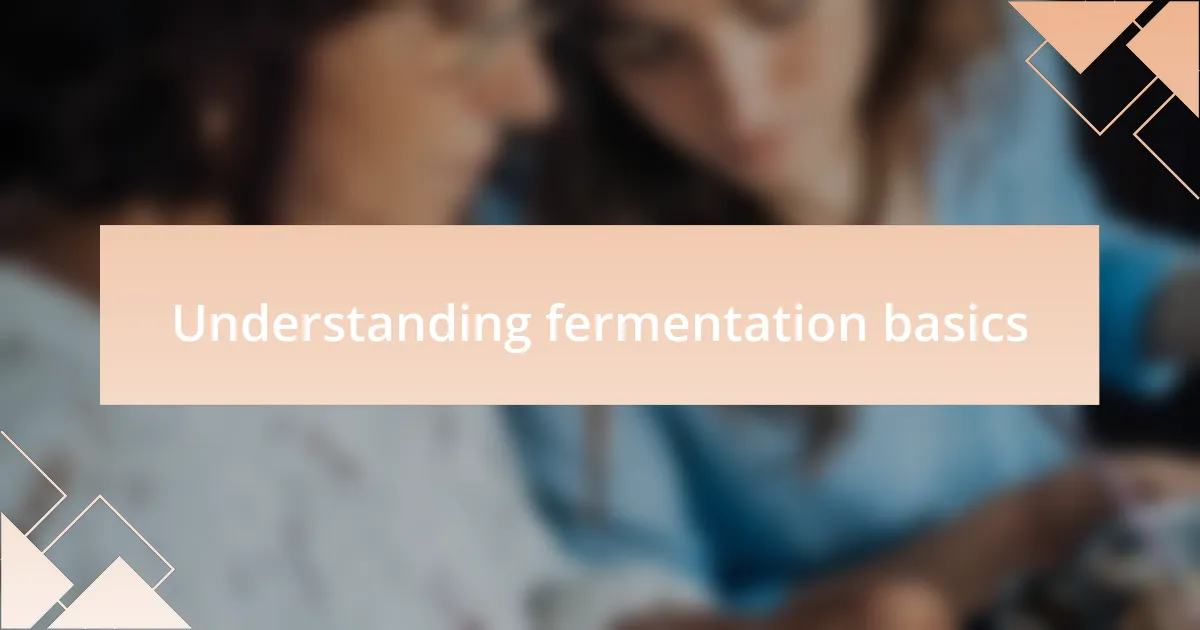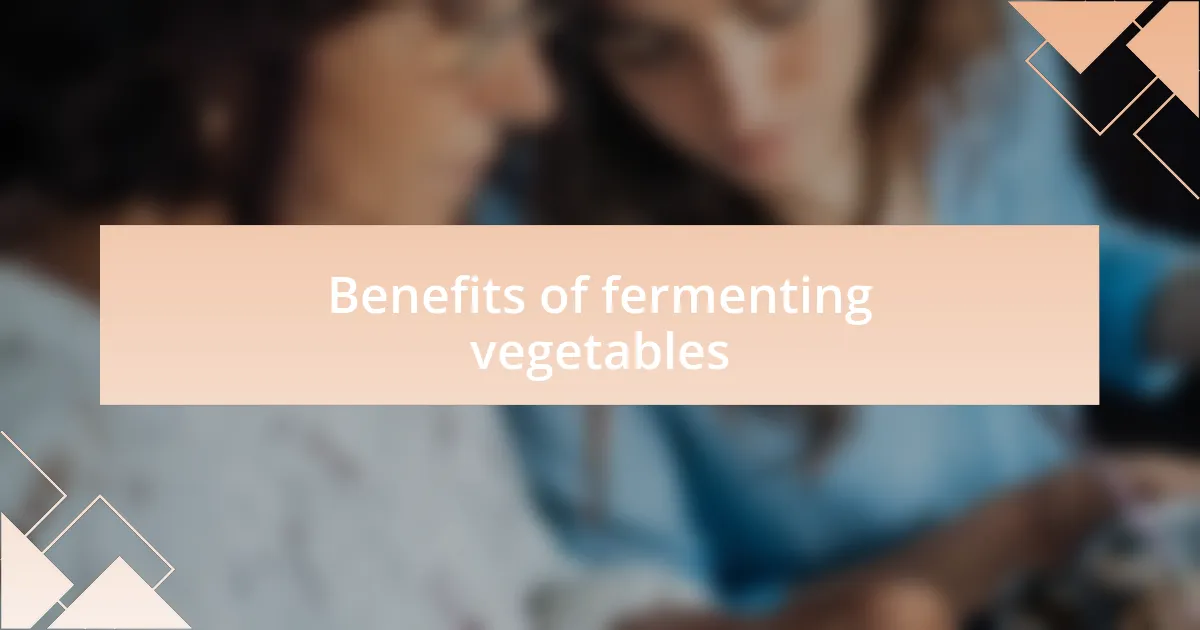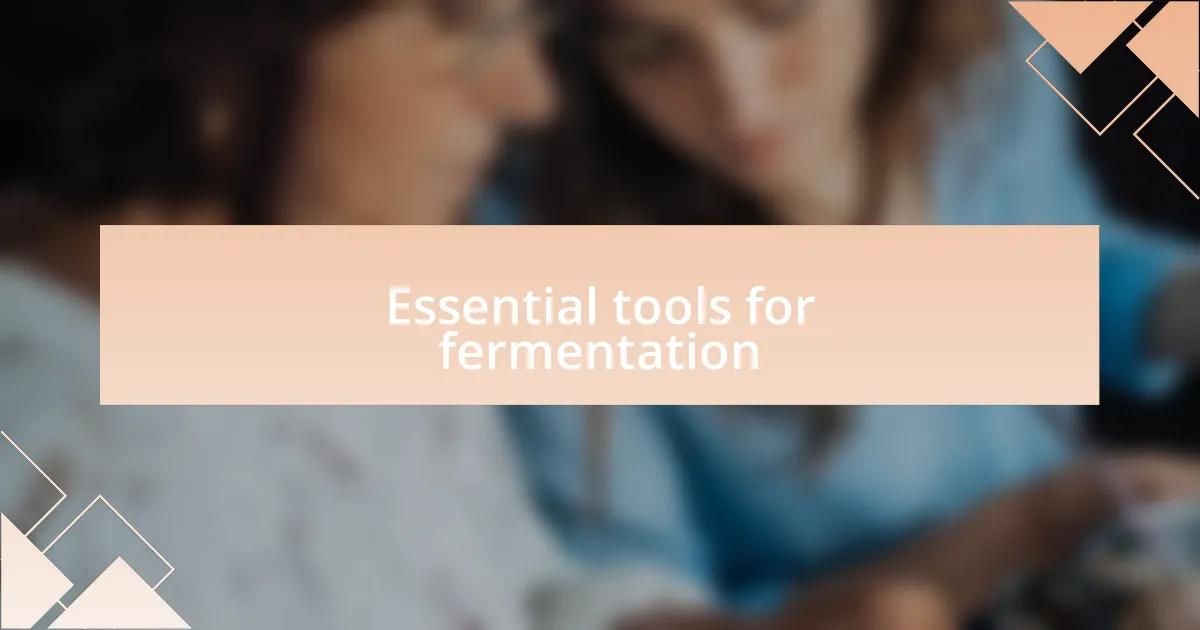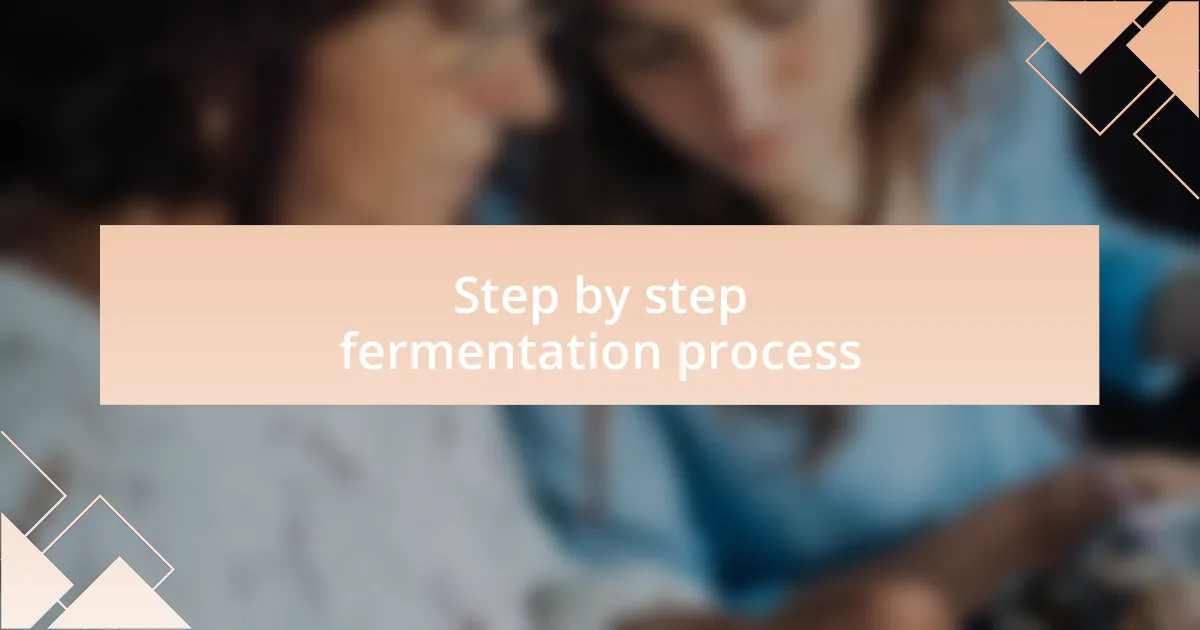Key takeaways:
- Fermentation transforms sugars into acids, gases, or alcohol, enhancing flavors and preserving vegetables.
- Fermented foods improve gut health through probiotics, and they also extend shelf life, reducing food waste.
- Essential tools for fermentation include glass jars with airlocks, weights for submerging vegetables, and pH meters for monitoring acidity.
- Experimenting with spices, fresh herbs, and acidity can significantly enhance the flavor profiles of fermented vegetables.

Understanding fermentation basics
Fermentation is essentially a transformative process where microorganisms like bacteria, yeasts, and molds convert sugars into acids, gases, or alcohol. This natural process not only preserves vegetables but also enhances their flavors and nutritional profiles. Have you ever tasted a tangy pickle or a vibrant kimchi? That zestiness comes from fermentation, which can truly elevate your culinary experience.
I still remember the first time I opened a jar of homemade sauerkraut. The smell hit me, and I was surprised by the complex, sour aroma wafting through the air. It was a moment of realization: fermenting vegetables is not just about preservation; it’s an art that breathes life into simple ingredients. Understanding the science behind fermentation allows us to experiment courageously in our kitchens.
As I navigated my own fermentation journey, I discovered how variables like temperature and time can dramatically affect the outcome. Have you ever left a jar fermenting a bit too long? I did once; the results were less than appetizing! But each mishap taught me valuable lessons, turning my kitchen into a laboratory of flavors. Remember, the key to successful fermentation is patience and observation.

Benefits of fermenting vegetables
Fermenting vegetables offers a remarkable boost to our gut health, which is something I deeply value. When I first started incorporating fermented foods like kimchi into my diet, I wasn’t just adding tangy flavor—I was cultivating a healthier digestive system. The probiotics found in these fermented delights can enhance the gut flora, leading to improved nutrient absorption and overall well-being. Who wouldn’t want to feel lighter and more energized after a hearty meal?
Another benefit that often surprises people is the extended shelf life of fermented vegetables. I once accidentally prepared a massive batch of pickled radishes, and rather than waste them, I enjoyed them over several months. Their flavors only deepened and became more complex with time. This not only reduces food waste but also encourages creative meal planning. Don’t you find it exciting to think about how a jar of pickles can transform a simple salad or sandwich?
Moreover, the creative possibilities with fermented vegetables are endless. I recall a memorable dinner where I used my homemade beet kvass as a base for a unique salad dressing. The vibrant color and earthy taste added an unexpected twist, impressing my friends. Engaging with fermentation not only allows for culinary exploration but, in my experience, it also rekindles a connection to the ingredients and traditions behind our food practices. Have you tried fermenting anything beyond pickles yet? The world of flavors waiting to be discovered is truly vast!

Essential tools for fermentation
Fermentation requires a few essential tools that can elevate your culinary experience. One of my first investments was a quality glass jar with an airlock lid. Initially, I worried about whether my creations would spoil, but using that jar eased my concerns. The airlock allows gases to escape while keeping unwanted bacteria out, providing a safe environment for my fermentation experiments.
I also found that using weights inside the jar can be incredibly beneficial. When I started fermenting cucumbers, I quickly learned that keeping the veggies submerged in brine is crucial for preventing mold. I remember the first time I made a batch of sauerkraut; without the weight, I was left with a soggy mess on top! Now, I always use a fermentation weight, which gives me peace of mind and ensures that every batch will be crisp and delicious.
Lastly, I can’t stress enough the importance of a pH meter or pH test strips in your fermentation toolkit. When I started fermenting, I didn’t realize the significance of pH levels. I recall checking my homemade kimchi’s acidity and feeling relieved to know I was on the right track to safely confident flavor development. Monitoring acidity not only helps you ensure the safety of your food but also allows you to tailor flavors to perfection. Have you ever thought about how a simple tool can impact your fermentation game? It truly makes a difference!

Step by step fermentation process
The fermentation process begins with selecting the right vegetables. I remember my excitement when I first picked fresh cabbage from the farmer’s market to create sauerkraut. The crunchiness and freshness of the produce made all the difference. After washing and chopping my cabbage, I felt a rush of anticipation for the transformation that was about to happen.
Next, it’s crucial to make the brine. I learned through trial and error that getting the salt concentration right is essential for fermentation. I often started with a simple recipe and adjusted it based on my taste preferences. It blew my mind to see how a few sprinkles of salt could encourage beneficial bacteria to thrive—who knew seasoning could play such a pivotal role in food preservation?
Finally, the waiting game begins. I once impatiently checked my jars of kimchi daily, but I soon realized that patience pays off. Observing the bubbles form and the colors change was like witnessing a little miracle unfold in my kitchen. It was hard to resist but leaving my creations undisturbed for the recommended period truly allows the flavors to develop fully. Have you ever found yourself counting down days for something delicious to ferment? That anticipation is part of the joy!

Tips for flavoring fermented vegetables
When it comes to flavoring fermented vegetables, spices can be game-changers. I remember adding a touch of smoked paprika to my last batch of pickled carrots, and the result was a delightful smoky sweetness that kept me reaching for more. Have you ever experimented with spices in your ferments? Each new addition can create a unique taste profile, making it easy to customize according to your preferences.
Another tip is to incorporate fresh herbs, which can bring a bright, lively note to your ferments. I’ll never forget the time I tossed in some dill sprigs while preparing my pickles—it transformed them into a refreshing delight that complemented the crunch perfectly. Think about your favorite dishes; what herb could you weave into your recipes to elevate them?
Finally, don’t overlook the impact of acidity. I once decided to add a splash of apple cider vinegar to a kimchi blend, and it added a zing that made every bite pop. It’s fascinating how a little tweak in acidity can enhance the overall flavor and complexity. What flavors are you hoping to explore in your own ferments? Remember, the beauty of fermentation is in the experimentation.

Personal experiences with fermentation
Fermenting vegetables has been a transformative experience for me, especially when I first tried making sauerkraut at home. The aroma that filled my kitchen as the cabbage fermented was intoxicating, and I was surprised at how proud I felt when the flavors melded just right. Have you ever felt that almost magical moment when something you created tastes better than you could’ve imagined?
One of my more memorable fermentation experiments involved a rainbow of vegetables—carrots, radishes, and cucumbers—all packed into a jar together. Watching them change color and texture over the days was a lesson in patience and anticipation. I still remember the moment I cracked open that jar; the refreshing crunch mixed with the tanginess exploded in my mouth. It reminded me of summer picnics with family. What’s your favorite memory tied to food?
Another standout moment was when I accidentally left a batch of kimchi to ferment longer than intended. Initially, I was worried about the taste, but that extra time brought out an umami depth I had never experienced before. It was a reminder to embrace those unexpected outcomes; sometimes, they lead to the most delightful surprises. Have you learned something new from a fermentation mishap that changed your approach?